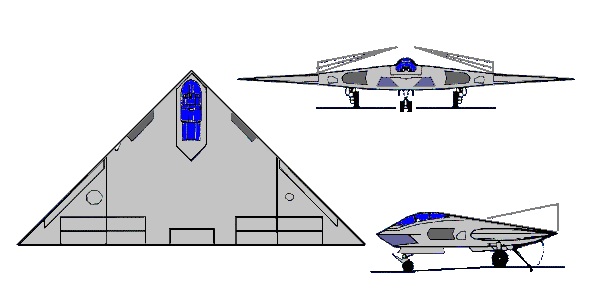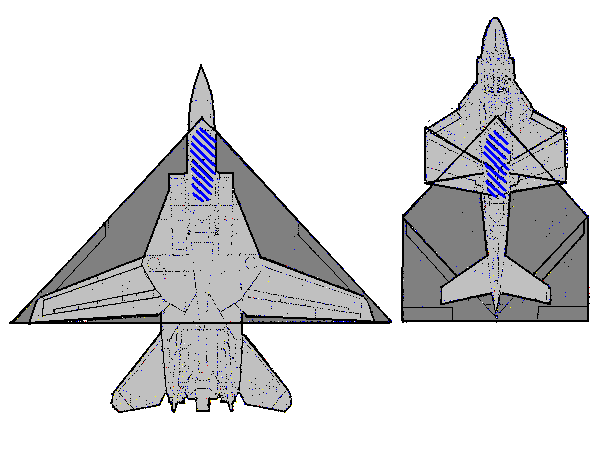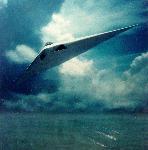





Plans for the Navy's A-12 combat aircraft called for incorporating more advanced stealthy characteristics than were used in the F-117A, as well as significantly greater payload capabilities. The Navy's A-12 Avenger Advanced Technology Aircraft (ATA) was slated to replace current A-6s on aircraft carriers in the mid-1990's.
But on 7 January 1991, Secretary of Defense Richard Cheney canceled the program, in the largest contract termination in DoD history. By one estimate the A-12 had become so expensive that it would have consumed up 70 percent of the Navy's aircraft budget within three years.
The Navy originally planned to buy 620 of the McDonnell Douglas/General Dynamics aircraft, with the Marine Corps purchasing an additional 238 planes. And the Air Force at one point considered buying 400, at an average cost that was estimated at close to $100 million each. The A-12 was designed to fly faster and further than the A-6E, and carry a large bomb-load in internal bomb-bays to reduce drag and maintain a low radar cross-section. As with the Advanced Tactial Fighter (ATF), the A-12 was expected to have greater reliability than current aircraft (double that of the A-6E), and require half the maintenance manhours.
At first blush, the A-12's performance capabilities would have been in roughly the same class as existing aircraft. The key improvement over existing aircraft, not inherently obvious when comparing specifications, was stealth. While today's radar can detect existing naval aircraft at a range of 50 miles, the A-12 was designed to remain undetected until approximately 10 miles away. This would result in significant operational and survival benefits for the A-12 since defenders would have little opportunity to engage the aircraft once detected so close to the target. The A-12's reduced radar cross section would have been derived, in part, from carrying its ordnance internally. While the top speed of the more visible F/A- 18 and A-6 would be significantly reduced by the drag induced by external weapons carriage, the internal weapons bay on the A-12 would provide no impediment to speed.
The A-12 proved to be the most troubled of the new American stealth aircraft in large part because of problems found in the extensive use of composites in its structure. These composites did not result in anticipated weight savings, and some structural elements had to be replaced with heavier metal components. The weight of each aircraft exceeded 30 tons, 30% over design specification, and close to the limits that could be accommodated on aircraft carriers. The program also experienced problems with its complex Inverse Synthetic Aperture Radar system, as well as delays in its advanced avionics components.
The full scope of these problems were not appreciated at the time of Defense Secretary Cheney's Major Aircraft Review, which slowed the production rate and dropped 238 Marine Corps aircraft, leaving the original total Navy buy of 620 aircraft. Cheney also decided to delay for over 5 years the Air Force buy (from 1992 to 1998), which was decoupled from the Navy project. Subsequently, the A-12 contractors revealed that the project faced serious engineering problems and a $2 billion cost overrun, which would delay the first flight by over a year, to the fall of 1991, and raised the unit cost substantially.
According to the 1990 administrative inquiry conducted for the Secretary of the Navy, the cost performance data from the A-12 contractors clearly indicated significant cost and schedule problems. The results of an oversight review of the cost performance reports disclosed that the A-12 contract would probably exceed its ceiling by $1 billion. However, neither the contractors nor the Navy program manager relied upon this data; instead, they used overly optimistic recovery plans and schedule assumptions. The inquiry concluded that the government and contractor program managers lacked the objectivity to assess the situation and they disregarded financial analysts who surfaced the problems.
The U.S. Navy on January 7, 1991, notified McDonnell Douglas and General Dynamics Corporation (the Team) that it was terminating for default the Team's contract for development and initial production of the A-12 aircraft, and demanded repayment of the amounts paid to the Team under such contracts. The Department of Defense terminated the contract after the contractors failed to deliver a single airplane after receiving more than $2 billion in payments. Instead, the contractors refused to continue with the contract unless they received extraordinary relief in the form of relaxed terms and extra funds. At the same time, they would or could not assure delivery of an aircraft by a time certain, specify the aircraft's performance capabilities, or commit to a specific price for the aircraft. The Team filed a legal action to contest the Navy's default termination, to assert its rights to convert the termination to one for "the convenience of the Government," and to obtain payment for work done and costs incurred on the A-12 contract but not paid to date.
On December 19, 1995, the U.S. Court of Federal Claims ordered that the Government's termination of the A-12 contract for default be converted to a termination for convenience of the Government. On December 13, 1996, the Court issued an opinion confirming its prior no-loss adjustment and no-profit recovery order. In an early 1997 stipulation, the parties agreed that, based on the prior orders and findings of the court, plaintiffs were entitled to recover $1.071 billion. Furthermore, on January 22, 1997, the court issued an opinion in which it ruled that plaintiffs are entitled to recover interest on that amount.
The government appealed the United States Court of Federal Claims ruling in of 20 February that awarded $1.2 billion to Boeing and General Dynamics. The Department of Defense argued that the court incorrectly ruled in favor of the contractors and that the award provides unwarranted relief from a failure to produce the aircraft for which the contractors werefully responsible. The Federal Claims Court decision was fully expected based upon earlier rulings by the trial judge; the government has made clear its belief that those earlier rulings were fundamentally flawed. A US Appeals Court overturned the award to Boeing and General Dynamics in July 1999, ruling that trial judge used the wrong legal test before issuing the damgage awards. The trial judge reversed himself in September 2001, ruling that the government was justified in cancelling the A-12 program. The issue remains unsettled, interrupting the Navy's FY 2003 procurement agenda because lawmakers want the case settled before awarding an $810 million contract fora third DDG-51 destroyer to Bath Iron Works (BIW), a subsidiary of Boeing.



Specifications | |
| Function | Carrier-based land-attack |
| Contractor | |
| Unit Cost | |
| Propulsion | |
| Thrust | |
| Length | 37 feet 3.0 inches |
| Wingspan |
70 feet 3.2 inches 36 feet 3.2 inches with wings folded |
| Height |
11 feet 3.4 inches 12 feet 6.2 inches with wings folded |
| Maximum Takeoff Weight | |
| Ceiling | |
| Speed | |
| Crew | Two |
| Armament | |
| Date Deployed | |
| First flight | |
| Inventory | |